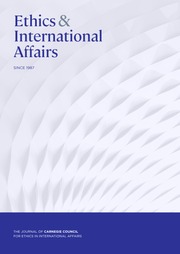Article contents
Poverty and Global Justice
Published online by Cambridge University Press: 25 March 2011
Abstract
Poverty eradication has been identified as the largest challenge facing international society in its quest for a peaceful, prosperous, and just world. I respond to this challenge by proposing a global poverty eradication principle. Grounded in John Rawls's account of human rights and assistance for the law of peoples, the global poverty eradication principle applies regardless of causal patterns that may obtain in a given case. The relationship between persons affected by poverty and their governments has implications only for the selection of the appropriate means of poverty eradication, but never undermines the goal of poverty eradication itself. The duties of human rights and assistance that establish the global poverty eradication principle apply even to societies that may reject them, because they are institutional reaffirmations of the natural duties of persons in the context of international society, without whose affirmation no domestic society can be considered well-ordered. I conclude by pointing out some of the challenges that are likely to arise in the application of the global poverty eradication principle. While I cannot hope to settle these practical problems philosophically, flagging them helps to clarify the scope of application of the global poverty eradication principle and gives a sense of the concrete targets and measures that could be adopted in working toward its fulfillment in practice, especially for the elimination of certain types of severe deprivation at a minimum.
- Type
- Features
- Information
- Copyright
- Copyright © Carnegie Council for Ethics in International Affairs 2007
References
Notes
1 The language of peace, prosperity, and justice comes directly from United Nations General Assembly Resolution A/RES/55/2. For the international commitment to poverty eradication, see United Nations General Assembly Resolution A/RES/51/178; United Nations General Assembly Resolution A/RES/59/247; Copenhagen Declaration and Programme of Action adopted at the World Summit for Social Development in 1995; available at http:\\www.un.org/esa/socdev/wssd/agreements/decpartc.htm; Monterrey Consensus of the International Committee on Financing for Development of 2002; statements of the United Nations World Summit on Sustainable Development of 2002; and the Chairman's Summary of the Gleneagles Summit of G-8 Ministers of 2005; available at http:\\www.number-10.gov.uk/output/Page7883.asp.
2 Statistics on poverty and its consequences can be found in World Bank, World Development Indicators (Washington, D.C.: World Bank, 2007); available at http:\\www.worldbank.org/data/wdi2005/pdfs/Table2_5.pdf; United Nations Development Programme, Human Development Report; available at http:\\www.hdr.undp.org/; and United Nations Statistics Division, Social Indicators of Poverty; available at http:\\www.un.org/Depts/unsd/social.
3 John Rawls, The Law of Peoples (Cambridge, Mass.: Harvard University Press, 1999), p. 37.
4 Ibid., p. 89.
5 Ibid., p. 7.
6 John Rawls, Political Liberalism, paperback ed. (New York: Columbia University Press, 1996), pp. 291–94.
7 Rawls, The Law of Peoples, p. 65.
8 Ibid., p. 65, n. 1.
9 Ibid., p. 5.
10 Ibid., p. 90–91.
11 Ibid., p. 81.
12 Ibid.
13 Ibid., p. 93.
14 Ibid., p. 81, n. 26.
15 Ibid., p. 94, n. 6.
16 Ibid.
17 Ibid., pp. 4, 63, 92.
18 Ibid., p. 92.
19 Ibid., p. 106.
20 Ibid., p. 90.
21 Ibid., pp. 5, 37, 106.
22 Ibid., p. 118.
23 Ibid., p. 116.
24 Ibid., pp. 112–13.
25 Ibid., pp. 9, 93.
26 Allen Buchanan, “Rawls's Law of Peoples: Rules for a Vanished Westphalian World,” Ethics 110 (July 2000), pp. 697–721.
27 Unlike ideal theory, which assumes full compliance and favorable conditions, nonideal theory is the part of Rawls's theory of justice that deals specifically with noncompliance and unfavorable conditions.
28 Rawls, The Law of Peoples, p. 109.
29 Ibid., p. 110.
30 Ibid., p. 80–81.
31 Ibid., p. 81.
32 Ibid., p. 80.
33 Ibid., p. 68.
34 John Rawls, A Theory of Justice(Cambridge, Mass.: Harvard University Press, 1971), p. 115.
35 Ibid., p. 108.
36 Ibid., pp. 109, 114, 355.
37 The distinction between positive and negative duties is not very important for Rawls, especially since it can easily get blurred. Rawls, A Theory of Justice, p. 114.
38 Rawls, A Theory of Justice, pp. 339–40.
39 Ibid., p. 341.
40 Ibid., p. 114.
41 Ibid., pp. 114–15.
42 Ibid., p. 115.
43 Ibid.
44 Ibid., p. 114.
45 Ibid., p. 115.
46 Ibid., p. 111.
47 Ibid., p. 110.
48 Ibid., pp. 338–39.
49 Ibid., p. 339.
50 Ibid., p. 338.
51 Ibid., p. 339.
52 Ibid., p. 110.
53 Ibid.
54 Independent Commission on International Development Issues, North-South: A Programme for Survival (Cambridge, Mass.: MIT Press, 1980), pp. 49–50.
55 Jeffrey Sachs, The End of Poverty: Economic Possibilities for Our Time (New York: Penguin, 2005), p. 20; United Nations Millennium Project, Investing in Development: A Practical Plan to Achieve the Millennium Development Goals (2005); available at http:\\www.unmillenniumproject.org/reports/fullreport.htm; and International Labour Organization, Perspective on Poverty (2005); available at http:\\www.ilo.org/public/english/comp/poverty/perspect.htm.
56 Rawls, The Law of Peoples, pp. 111, 116, 113–19.
57 United Nations Development Programme, Human Development Report 2004: Cultural Liberty in Today's Diverse World (Oxford: Oxford University Press, 2004), p. 259.
58 HPI-1 assesses data from the developing world, while HPI-2 analyzes data from countries belonging to the Organization for Economic Co-operation and Development (OECD).
59 Amartya Sen, Development as Freedom (New York: Knopf, 1999), p. 21.
60 Ibid., pp. 23–24.
61 Rawls, The Law of Peoples, pp. 94–97.
62 Ibid., p. 108.
63 United Nations Millennium Project, Investing in Development.
64 Ibid.
65 World Bank, World Development Report 1997: The State in a Changing World (Oxford: Oxford University Press, 1997); and World Bank, World Development Report 2000/2001: Attacking Poverty (Oxford: Oxford University Press, 2000/2001).
66 United Nations Millennium Project, Investing in Development, p. 204.
67 Rawls, A Theory of Justice, pp. 8, 244–45, 575. For legal sanctions, see Rawls, A Theory of Justice, pp. 240, 249, 575–76.
68 Ibid., p. 8.
- 7
- Cited by




